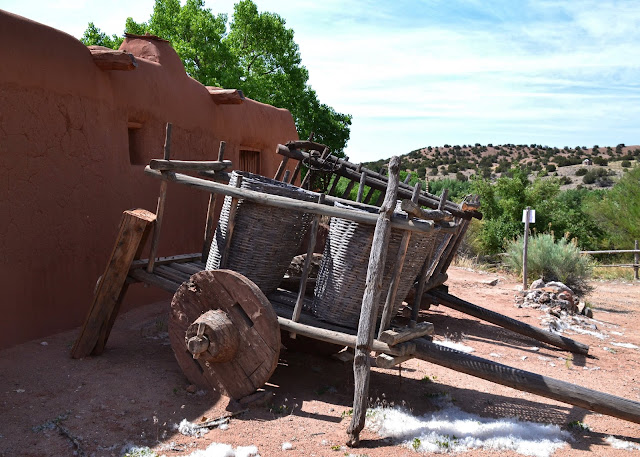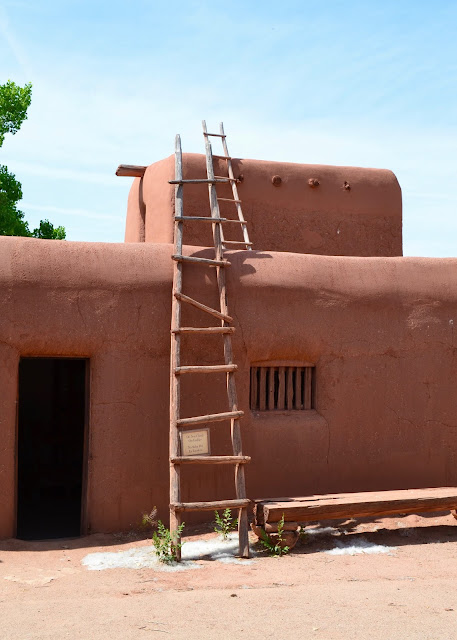Las Golondrinas
What a process. My new computer is finally functional, but it took many days in the shop, an hour with tech support on the phone after it came home, and it still isn't completely right. But it works now. It works fine.
Right now I have family visiting and we are eating out, dining in, visiting some Santa Fe tourist sites and drinking wine on the deck. We went to the ranch at Las Golondrinas, a living history museum at a site that dates from 1629. It's a small fortified farm just south of Santa Fe, that supported maybe 30 people -- Spanish settlers, Pueblo Indian slaves, and farm workers.
It would have been about a day's horseback ride from Santa Fe's center, and a good place for travelers to stop along the Camino Real -- the royal road to Mexico City.
They have recreated the compound as it would have been in the 1700s. Archeological work goes on to excavate what remains from the 1600s, but the restored buildings and farm space open to the public shows how they lived and worked a century after it was established.
The colonial Spaniards here raised sheep, wove beautiful textiles and fed themselves. This was all before the railroad came to northern New Mexico, and the docents did a god job of showing us how utterly isolated their lives were and how ingenious they were in making what they needed to live, using only what could be carried down from the mountains (lumber), traded with the native people and other far flung outposts along the Camino Real road to Mexico (pots and utensils), or grown themselves (rope fibers, wool, food).
They had only what the land could provide and occasional traders or visiting priests on burro could supplement. While lots of material goods were available in Mexico in the 1700s, it was just too far inland and too difficult over challenging roads to get much stuff to the frontier of northern New Mexico. Their enclosed compound was on constant guard against raiders from the outside.
A second section of the site shows living conditions as they were in the 1800s, after the railroad came to Santa Fe and easier access to all kinds of goods came with it. Still primitive to our eyes, but such an improvement in living arrangements.
Las Golondrinas means "the swallows" in Spanish. The land is dry and difficult, but the farm compound was situated near marshy banks of the Santa Fe river, and there must have been swallows and other birds in the leafy river bottoms that captivated (or fed) the settlers.
We saw no swallows on our visit, just sheep, some recently shorn for the spinning that the docents were doing by hand. Volunteers do all the shearing by hand too, using no electric shears, just forearm power and big scissors.
The ranch at Las Golondrinas was assembled from buildings that were brought in from other parts of New Mexico as well as by restoring the buildings that were already here. It was all due to Leonora Curtin and her husband -- she was the founder of Santa Fe's Native Market in the 1930s to reestablish native crafts and provide an income during the Depression to native pueblos. She bought the ranch property and then over many decades rebuilt and restored it as a living museum.
The ranch is 200 acres, and the area around the compound is set up for large groups: buses of school kids visit and several times a season Las Golondrinas holds big festivals -- a sheep shearing event, a wine festival, a harvest celebration, a Mexican food and beer fiesta and more.
But the compound itself is compact and easily navigated even on a hot day, and well worth the visit. And on Wednesdays New Mexico residents (that's us now!) get in for free. How can you beat that?
Right now I have family visiting and we are eating out, dining in, visiting some Santa Fe tourist sites and drinking wine on the deck. We went to the ranch at Las Golondrinas, a living history museum at a site that dates from 1629. It's a small fortified farm just south of Santa Fe, that supported maybe 30 people -- Spanish settlers, Pueblo Indian slaves, and farm workers.
It would have been about a day's horseback ride from Santa Fe's center, and a good place for travelers to stop along the Camino Real -- the royal road to Mexico City.
They have recreated the compound as it would have been in the 1700s. Archeological work goes on to excavate what remains from the 1600s, but the restored buildings and farm space open to the public shows how they lived and worked a century after it was established.
The colonial Spaniards here raised sheep, wove beautiful textiles and fed themselves. This was all before the railroad came to northern New Mexico, and the docents did a god job of showing us how utterly isolated their lives were and how ingenious they were in making what they needed to live, using only what could be carried down from the mountains (lumber), traded with the native people and other far flung outposts along the Camino Real road to Mexico (pots and utensils), or grown themselves (rope fibers, wool, food).
They had only what the land could provide and occasional traders or visiting priests on burro could supplement. While lots of material goods were available in Mexico in the 1700s, it was just too far inland and too difficult over challenging roads to get much stuff to the frontier of northern New Mexico. Their enclosed compound was on constant guard against raiders from the outside.
A second section of the site shows living conditions as they were in the 1800s, after the railroad came to Santa Fe and easier access to all kinds of goods came with it. Still primitive to our eyes, but such an improvement in living arrangements.
Las Golondrinas means "the swallows" in Spanish. The land is dry and difficult, but the farm compound was situated near marshy banks of the Santa Fe river, and there must have been swallows and other birds in the leafy river bottoms that captivated (or fed) the settlers.
We saw no swallows on our visit, just sheep, some recently shorn for the spinning that the docents were doing by hand. Volunteers do all the shearing by hand too, using no electric shears, just forearm power and big scissors.
The ranch at Las Golondrinas was assembled from buildings that were brought in from other parts of New Mexico as well as by restoring the buildings that were already here. It was all due to Leonora Curtin and her husband -- she was the founder of Santa Fe's Native Market in the 1930s to reestablish native crafts and provide an income during the Depression to native pueblos. She bought the ranch property and then over many decades rebuilt and restored it as a living museum.
The ranch is 200 acres, and the area around the compound is set up for large groups: buses of school kids visit and several times a season Las Golondrinas holds big festivals -- a sheep shearing event, a wine festival, a harvest celebration, a Mexican food and beer fiesta and more.
But the compound itself is compact and easily navigated even on a hot day, and well worth the visit. And on Wednesdays New Mexico residents (that's us now!) get in for free. How can you beat that?
 |
| las golondrinas -- the swallows |








Comments